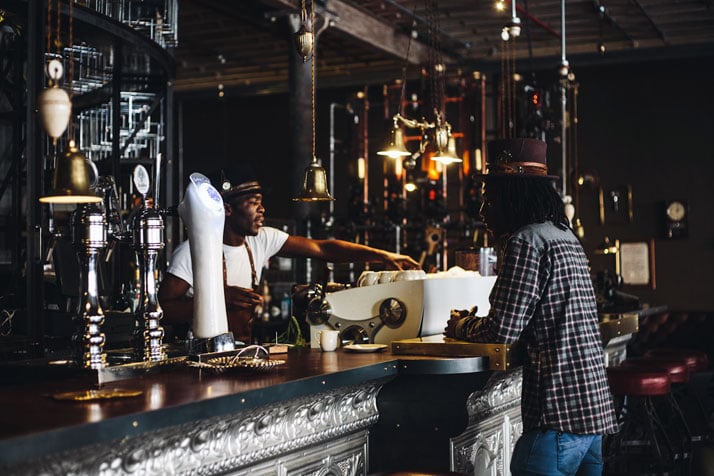While steampunk homes often reflect the personal tastes of the homeowners and allow for a customization that enables explorations of identities and environments of escape, steampunk design is also found within public buildings, shops, and workspaces. An example of a complete space that is decorated in the steampunk style is the coffee shop Truth Coffee, located in Cape Town, South Africa.
The Steampunked space has a ceiling adorned with metal pipes, and vintage goods such as Singer sewing machines, old typewriters, and candlestick telephones fill the space with steampunk aesthetics. Saw-blade tabletops furnish the environment, and even the washrooms are fully decorated in steampunk aesthetics with Victorian tap levers and large vintage mirrors. The shop's pride, and the inspiration for the steampunk decor, is Professor Jones's Fabulous Coffee Bean Contraption, which is an enormous machine made of several cylinders containing different coffees that works on a crank handle and ratchet system (Midlane).
While individuals designing their homes are able to add elements and steampunk aesthetics that appeal directly to their individual tastes, establishments using steampunk decor must do so in a style that appeals to a larger demographic in order to attain customers. A problem with the shift towards appeasing a collective audience rather than designing individualistic spaces that develop and demonstrate personal identities is the fact that the commercialization of the space may take precedence over the designer(s)’s independent wants. The ‘punk’ in steampunk often involves individuals’ creative expressions through personally developed and designed or do-it-yourself creations and a dismissal of mass produced or commercialized objects. By creating a coffee shop outfitted in steampunk decor to attract customers, one may understand that the essence of the genre reflected in the interior design is actually changed into a ploy to draw in buyers and is, therefore, used for a financial gain.
The notion of the shop being outfitted in steampunk aesthetics to gain attention is only one perspective, however. One of the shop owners, David Donde, comments that the shop, “does tend to attract more interesting, quirky people than your standard coffee shop” (Midlane). Perhaps the commercialization of the space necessary to bring in business does not reflect attitudes of mass consumption and the power of large corporations, but of the openness of the steampunk design and the availability of a public space for steampunkers or possible-steampunk enthusiasts to escape from mainstream decor to a visually appealing space regardless of their personal financial status. As discussed,in this previous post, steampunk as a form of interior design is costly, and not all of those who wish to outfit their homes with the aesthetics are able to based on their personal finances. The coffee shop may help to alleviate this problem, for anyone is able to come into Truth Coffee and enjoy the atmosphere.
Another positive aspect of the space that contributes to the heightened availability of steampunk design for individuals regardless of their finances is the opportunities for jobs within the shop. As steampunk homeowners may find their houses to be environments of escape from workspaces and public atmospheres, those steampunk enthusiasts who are employed in Truth Coffee may escape while at work. Steampunkers who are unable to financially gain from their love of steampunk like steampunk aesthetic creators Datamancer and ModVic owners Melanie and Bruce Rosenbaum because of lack of skills such as technological or trade skills knowledges required for do-it-yourself projects within a steampunk home may be able to gain money within a steampunk environment that they love.








No comments:
Post a Comment